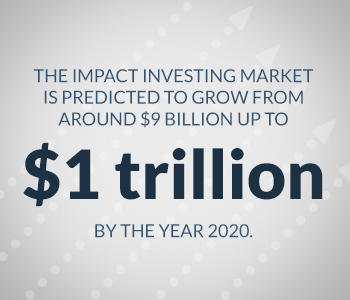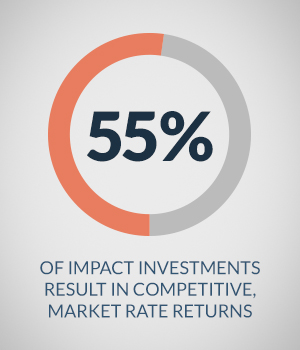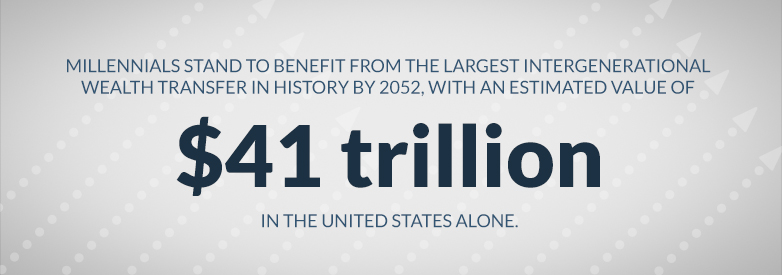
Millennials Helping Others Through Their Investments
“Doing well” and “doing good” do not have to be mutually exclusive concepts. With impact investing, it is possible to use your investments as an economic expression of your values and support projects you believe will generate positive outcomes for society as a whole. Impact investing is growing among all investors, but millennials have expressed a particular interest in this type of investment opportunity as a way to support their desire to help others while working toward their goal of a secure financial future.
How to Help Others by Investing
Traditionally, the sole purpose of investing was to generate a profit. However, there is a growing group of people who feel that simply increasing their wealth is not enough. They want to use their resources to make a meaningful contribution to the world.
The term impact investment was coined around 2007 at The Rockefeller Foundation as a way to refer to socially responsible investing. Impact investors still want to make money, but they wish to do so in a way that helps to support the goals that existing philanthropic groups and organizations are struggling to accomplish. These goals can be very specific, such as creating facilities that provide safe drinking water to residents of a particular region of Africa, or they can be more general, such as a global initiative to support education.
The size of the impact investing market continues to grow each year. A JPMorgan report in 2013 estimated the market at $9 billion and predicted a growth of up to $1 trillion by 2020.
Impact investing opportunities for young adults can be found in:
 Access to education: Providing learning opportunities to students who were previously unable to attend class due to cost-prohibitive fees or living too far from a suitable educational institution.
Access to education: Providing learning opportunities to students who were previously unable to attend class due to cost-prohibitive fees or living too far from a suitable educational institution.- Access to energy: Improving access to electricity by supporting infrastructure in impoverished countries.
- Access to water: Working to ensure that all households have at least 20 liters of water per person per day and access to clean water within one kilometer of their home.
- Access to healthcare: Supporting access to medical care among low income people or those who live in rural areas without suitable hospitals or doctor’s offices.
- Affordable housing: Ensuring access to safe housing at a cost level that does not threaten the resident’s ability to pay for food, clothing, medical care and other necessary expenses.
- Renewable energy: Projects relating to the development of heat and electricity through solar, wind, ocean, biomass, hydropower or geothermal resources.
- Microfinance: The practice of providing credit, savings, insurance and remittances to low-income individuals or businesses that are not currently being served by traditional financial institutions
The legal structure of organizations seeking impact investors can vary widely. Companies may be set up as a for-profit, not-for profit, Low-profit Limited Liability Company, Community Interest Company, B Corporation or other country-specific designations.
Impact investing occurs across asset classes and can encompass venture capital, private equity, debt and fixed income.
Impact Investing vs. Charitable Donations
An impact investment is not a charitable donation. Donations made to charity are given exclusively based on support for the organization’s mission, without an expectation of anything in return. In comparison, impact investments have four core traits:
- Intentionality: The impact investor purposefully tries to generate social or environmental impact through the act of investing in a specific organization.
- Return expectations: An impact investment is expected to either generate a financial return on capital or to preserve the capital that is provided.
- Range of returns and asset classes: Depending upon their goals, impact investors may be willing to accept below market or concessionary returns.
- Impact measurement: To promote accountability and transparency, impact investments involve a commitment to measuring and reporting the performance of the investment.
Impact Investing vs. Venture Philanthropy
The term ‘venture philanthropy’ was first used by John D. Rockefeller III in 1969 to refer to “an adventurous approach to funding unpopular social causes.”
Venture philanthropy shares many traits with impact investing, but there are some differences to consider. Venture philanthropy differs from impact investing in that venture philanthropy works to build capital and promote performance improvement as opposed to funding an organization’s general expenses or specific individual projects.
The time commitment involved is another key difference. There is generally a set time frame for a venture philanthropist’s involvement, with a minimum of three years and an average of five to seven years. With impact investing for millennials, the investor does not set a time limit and is generally willing to support the cause as long as it takes to see results.
Does Impact Investing Work?
The principles of impact investing are quite simple:

- You do not need to sacrifice your moral values to generate a return on your investment.
- The private sector can be a force for good, utilizing leadership skills and access to resources that are not readily accessible in the public sector.
- Well-researched investments can help bring the resources, incentives and innovation associated with private business into the public sector.
A survey by the Global Impact Investing Network (GIIN) and JPMorgan found that 55% of impact investment opportunities result in competitive, market rate returns. The survey also showed that portfolio performance for impact investments overwhelmingly met or exceeded investor expectations in terms of both financial goals and social or environmental impact.
Elaborating on the theme of investment impact, Debra Schwartz, director of program-related investments at the MacArthur Foundation, summarizes the capital benefits investors can provide in terms of the five P’s:
- Price: Offering below-market investments when appropriate
- Pledge: Providing loan guarantees
- Position: Investments with subordinated debt or equity positions
- Patience: Agreeing to longer terms before exit
- Purpose: Giving enterprises flexibility in using investment capital to suit their specific needs
Using IRIS Standards to Evaluate the Performance of Impact Investments
It is much easier to measure the financial success of an investment than any social or environmental returns. With philanthropic projects designed to improve access to education or medical care, the full effects of the work are not immediately seen by the casual observer. However, having access to standardized progress metrics is a key component in educating those interested in impact investment opportunities.
Impact Reporting and Investment Standards (IRIS) help to standardize measurements of a particular organization’s financial, social and environmental performance. Over 5,000 organizations are currently using IRIS to manage their investment performance in six social and environmental sectors:
- Agriculture
- Education
- Energy, environment and water
- Financial services
- Health
- Housing and community facilities
IRIS works by using both cross-sector and sector-specific metrics to produce a detailed look at the effectiveness of an impact investment. Cross-sector metrics apply to all investments and include criteria such as the number of permanent employees or target beneficiary demographic. Sector-specific metrics apply to only one of the six IRIS sectors. For example, health investments can be evaluated by health-related well visits defined as the number of wellness oriented visits or screenings, including immunization appointments, conducted by the organization during the reporting period. In the energy, environment and water sector, potable water produced is an example of a sector-specific metric that gives investors detailed performance data.
IRIS is managed by GIIN, a nonprofit that is working to increase awareness of impact investing. GIIN plans to release IRIS 4.0 metrics in early 2016. This important update will introduce aanalytical guidance using more than 30 new ratios for measurement analysis.
Impact Investing as a Millennial Is on the Rise
Impact investing can be done by both institutional and individual investors. On the individual investor side, millennials appear to be taking the lead in adopting this bold approach to managing their investments. Thanks to millennials, impact investing has moved from a fringe approach to a more of a mainstream practice.

Millennials are often portrayed in the media as spoiled, lazy and entitled, but these harsh generalizations could not be further from the truth. Having grown up during a time of expanding global awareness, millennials as a whole are curious about other cultures and eager to help those who are less fortunate. Research conducted by Mint.com found that 91% of millennial women and 84% of millennial men donate to charitable organizations, with 47% of all millennials also volunteering their time on a monthly basis.
A study by US Trust recently attempted to clarify the appeal of impact investing among millennials. The study uncovered several interesting points:
- Among people ages 18 to 32, 69% feel their investment decisions should also serve as a way to express their social, political and environmental values. Only 45% of all adult survey respondents over that age agreed with this statement.
- Lower returns on an investment in exchange for having a positive impact on society or the environment are acceptable for 61% of adults ages 18 to 32. Only 46% of all adults over that age felt the same way.
- Assuming a greater risk for an investment in exchange for having a positive impact on society or the environment is acceptable for 72% of adults ages 18 to 32. Only 44% of all adults older than 32 felt the same way, with tolerance for risk dropping steadily in every age bracket.
- Among millennials ages 18 to 32, 71% would turn down the opportunity to make a significant sum of money if it required investing in a company with a negative impact on society or the environment. Only 63% of all other respondents agreed they would walk away from an opportunity that did not match their personal values.
Even millennials who are currently of modest means express an interest in impact investments. This is significant because many millennial adults are anticipating substantial inheritances from their Boomer parents in the decades to come. The Harvard Business Review reports millennials stand to benefit from the largest intergenerational wealth transfer in history by 2052, with an estimated value of $41 trillion in the United States alone. With this added capital on their side, there is no limit to what savvy millennial investors can accomplish.

How Can Millennials Evaluate Impact Investment Opportunities?
Since impact investing focuses on the philanthropic effects of an investment in addition to its potential profitability, it is hard to identify just one “best” investment opportunity. However, the following questions serve as a general impact investment guide for millennials:
- What are your key interest areas? Ideally, your impact investments should support the causes you feel the most passionate about, whether that is education for children, reducing pollution in the environment or providing economic opportunities for people in third world countries.
- How much risk are you comfortable with? All investments carry some level of risk. How much risk you are comfortable with will depend upon factors such as your income, the size of the investment, how much you believe in the cause you are supporting and your personal temperament. Providing early stage capital is generally the riskiest form of impact investing, while supporting the expansion of an already established project is less risky.
- What are your requirements for a return on your investment? Most impact investments offer returns that are market rate, but this can vary. Having a minimum threshold for your return expectations will help you sort through investment opportunities more easily.
- Are you willing to accept a lower return on your investment for the opportunity to make a greater social impact? Willingness to accept a below market rate return is a personal preference. You can still be a successful impact investor if you would be more comfortable sticking to market investments.
- How hands-on do you want to be with your investment? A structured, pooled investment, such as a fund, is a relatively hands-off way to experience the benefit of impact investing. Working with investment circles or community advisors requires a more hands-on approach.
Key Impact Investing Terminology
Impact investing has its own unique terminology that millennials must be aware of as they are researching potential investment opportunities. For example:
- Blended value: Belief that the value of a non-profit or for-profit organization is equally financial, social and environmental — thus requiring that all constituents of value be taken into account when assessing investment opportunities.
- ESG: Abbreviation for Environment, Social and Governance — the three issues at the heart of impact investing.
- Financial first: Investors who place the financial return of an investment over its potential social or environmental benefits.
- Impact first: Investors who prioritize social or environmental good over achieving a financial return. They are willing to accept a below-market rate of return if they can help the progress of goals that are not achievable through mainstream philanthropic activities.
- Triple bottom line: Investments that hope to achieve three goals: financial, social and environmental returns. The triple bottom line concept is an accounting framework attributed to John Elkington.
HSC Wealth Advisors Can Help Guide Your Impact Investment Goals
If you are interested in learning more about impact investing, HSC Wealth Advisors can help. As of 02/28/2019, HSC Wealth Advisors had over $250 million in regulatory assets under management for nearly 350 households, offering assistance with investment strategies as well as 401k savings, pension options and tax planning.
As a fee-only wealth management firm, HSC Wealth Advisors does not accept commissions or compensation from any outside sources. This eliminates any conflict of interest when determining the best way to help our clients reach their investment goals.
Visit our Investing for Young Professionals page to for a basic overview of how to establish a solid financial foundation for the future. Then, sign up for our newsletter and request an information packet to learn more about how HSC Wealth Advisors can assist you with your impact investment goals.

